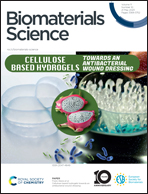Bio-piezoelectric phenylalanine-αβ-dehydrophenylalanine nanotubes as potential modalities for combinatorial electrochemotherapy in glioma cells†
Abstract
Bio-piezoelectric materials are endowed with characteristic features such as non-invasiveness, small energy attenuation and deep tissue penetrability. Thus, they have the ability to serve as both diagnostic and therapeutic modalities for targeting and treating various dreaded disorders scourging mankind. Herein, piezoelectric nanotubes derived from a modified amino acid-containing dipeptide, phenylalanine-αβ-dehydrophenylalanine (Phe-ΔPhe; FΔF), possessing acoustic stimulation-triggered reactive oxygen species (ROS) generating ability, were employed and projected for achieving a piezo-active response enabled anti-cancer effect in glioma cells. A model anti-cancer drug doxorubicin (Dox) was also loaded into the nanotubes and the combined system depicted enhanced ROS production and cell killing under an acoustically developed piezo-catalytic environment. Cellular level assessment studies demonstrated that the dipeptide based piezoelectric nanotubes could lead to an increase in the cellular Ca2+ ion concentration, further inducing ROS-triggered cytotoxicity accompanied by high therapeutic efficacy in C6 glioma cells. Overall, our structures have the uniqueness of serving as acoustic stimulus-driven, wireless, and non-invasive electro-chemotherapeutic agents for enabling heightened cancer cell killing and may complement other chemotherapeutic modalities for treating the disease.



 Please wait while we load your content...
Please wait while we load your content...